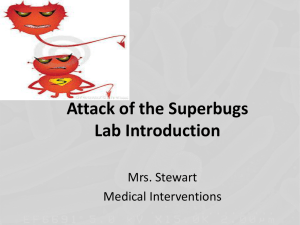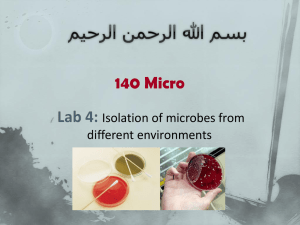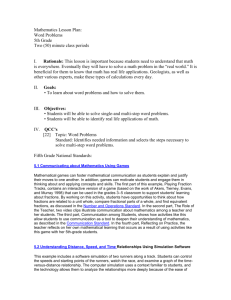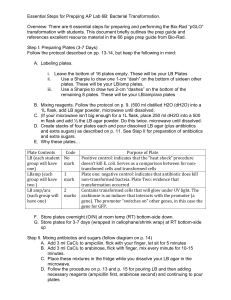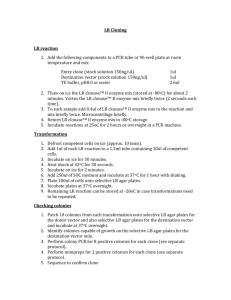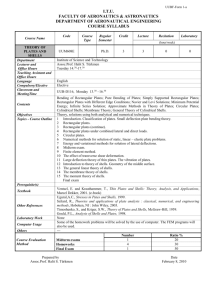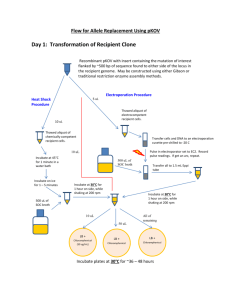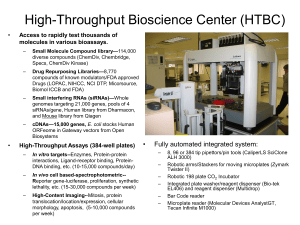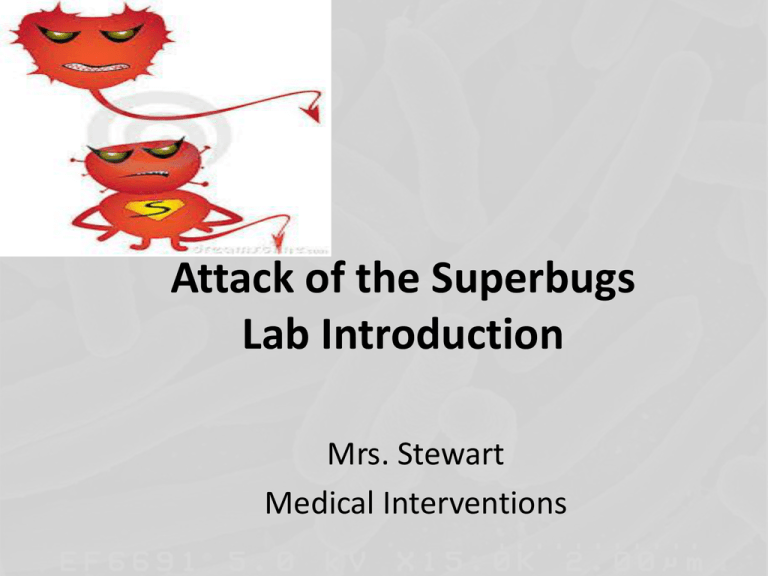
Attack of the Superbugs
Lab Introduction
Mrs. Stewart
Medical Interventions
Superbugs
• What is a
“superbug”?
– Bacteria that
have become
stronger and
less
responsive to
antibiotic
treatment
How can bacteria share resistance?
Genetic Transfer
Method
Conjugation
Description
The one-way transfer of DNA
(plasmid) between bacteria in close
cellular contact
Transformation
The genetic modification of a
bacterium by incorporation of free
DNA from the surrounding
environment (usually caused by
another ruptured bacterial cell)
Transduction
The transfer of genetic material from
one bacterium to another by a genetic
vector (bacteriophage virus)
This lab uses 2 types of Bacteria:
• E. coli I
– contains a gene found on the chromosomal DNA
coding for streptomycin resistance
• E. coli II
– contains a gene found on the plasmid DNA coding
for ampicillin resistance.
Predict
• What will happen when the E. coli I
strain is mixed with the E. coli II strain?
Lab Materials: 4 growth plates
LB Agar
LB + Amp
LB + Str
LB /Str /Amp
*LB Agar = growth medium for bacterial cells
Lab Day 1:
•
•
•
•
Obtain 2 of each type of growth plate
Streak E. coli I on 4 plates
Streak E. coli II on 4 plates
Incubate overnight
*These will be the confirmation plates
Evaluate
• What are we confirming?
Lab Day 2:
• Observe confirmation plate results
• Prepare “mix” plate
– You will literally be mixing the two types of
bacteria together onto one plate
• Incubate overnight
Evaluate
• Why are we mixing them together?
Lab Day 3:
• Use new “mixed” bacterial cultures and
spread onto the 3 types of antibiotic plates
Predict
• What would you expect to see on
these growth plates?
• Why?
FRIDAY – Lab Day 4
• You must come in at some point during the
day Friday to observe and record your results
• Remember: Pictures of lab results will be
required in your lab reports
*Growth plates will be discarded at 3:10 pm on
Friday. Any results not recorded will be lost.
Student Lab Schedule
Activity:
How to Store:
Day:
Time Needed:
Additional Info:
Lab Day 1
~ 30 minutes
Students prepare
confirmation plates.
Invert the plates,
label, and incubate
at 37˚C for 24
hours.
(1) Students complete steps
1 – 33 on P.1.2.2.
(2) Students work through
the mechanisms of antibiotic
resistance animations.
Lab Day 2
~ 30 minutes
Students observe
confirmation plates
and prepare “Mix
Plate.”
Invert the plates,
label, and incubate
at 37˚C for 24
hours.
(1) Students complete steps
34 – 47 on P.1.2.2.
(2) Students begin
construction of 3-D model.
Lab Day 3
~ 30 minutes
Students streak
cultures from “Mix
Plate” onto antibiotic
plates.
Invert the plates,
label, and incubate
at 37˚C for 24
hours.
(1) Students complete steps
48 – 60 on P.1.2.2.
(2) Students continue
construction of 3-D model.
Lab Day 4
~ 10 minutes
Students make
observations of plates
to test for antibiotic
resistance.
Clean-up all
materials.
(1) Students complete steps
61 – 65 on P.1.2.2.
(2) Students complete work
on 3-D models and present
models to class.
(3) Students answer all
remaining Conclusion
questions.


